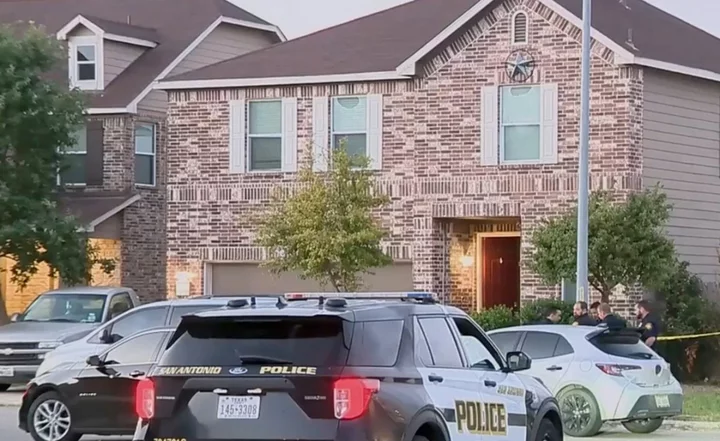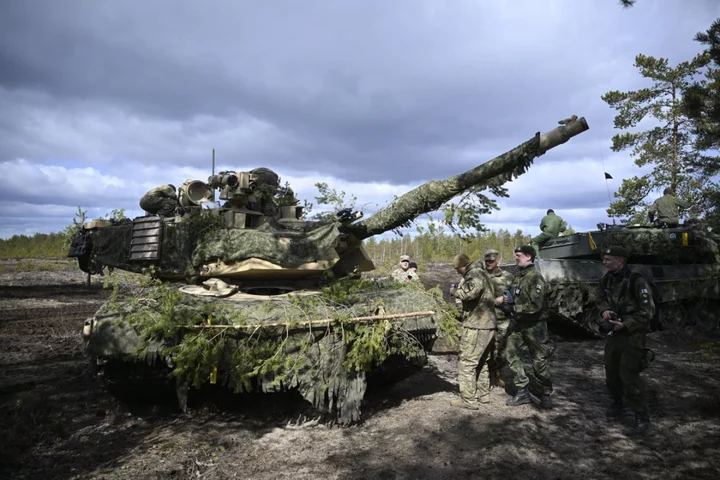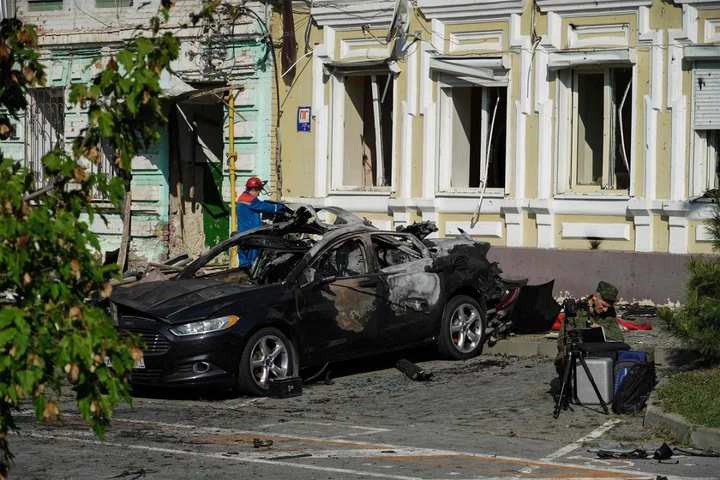
Chando Cosmetics Maker Jala Weighs $500 Million Hong Kong IPO, Sources Say
Jala Group, a Chinese cosmetics and skincare brand, is considering an initial public offering in Hong Kong that
1970-01-01 08:00

‘That ‘70s Show’ actor Danny Masterson faces 30 years to life at sentencing for rapes
“That ’70s Show” star Danny Masterson could get as much as 30 years to life in prison at his sentencing Thursday for the rapes of two women two decades ago. Los Angeles Superior Court Judge Charlaine F. Olmedo is set to sentence the 47-year-old actor after ruling on a defense motion for a new trial that she’s very likely to reject, and after hearing impact statements from the victims. A jury of seven women and five men found Masterson guilty of two counts on May 31 after seven days of deliberations. Both attacks took place in Masterson’s Hollywood-area home in 2003, when he was at the height of his fame on the Fox network sitcom “That ’70s Show.” The jury could not reach a unanimous verdict on a third count, an allegation that Masterson also raped a longtime girlfriend. The verdict came in a second trial after a jury failed to reach verdicts on three counts of forcible rape in December and a mistrial was declared. Prosecutors alleged that Masterson used his prominence in the Church of Scientology — where all three women were also members at the time — to avoid consequences for decades after the attacks. The women blamed the church for their hesitancy in going to police about Masterson. They testified that when they reported him to Scientology officials, they were told they were not raped, were put through ethics programs themselves, and were warned against going to law enforcement to report a member of such high standing. “They were raped, they were punished for it, and they were retaliated against,” Deputy District Attorney Reinhold Mueller told jurors at the trial. “Scientology told them there’s no justice for them.” The church said in a statement after the verdict that the “testimony and descriptions of Scientology beliefs” during the trial were “uniformly false.” “The Church has no policy prohibiting or discouraging members from reporting criminal conduct of anyone — Scientologists or not — to law enforcement,” the statement said. Masterson did not testify, and his lawyers called no witnesses. The defense argued that the acts were consensual, and attempted to discredit the women’s stories by highlighting changes and inconsistencies over time, which they said showed signs of coordination between them. The women whose testimony led to Masterson’s conviction said that in 2003, he gave them drinks and that they then became woozy or passed out before he violently raped them. Olmedo allowed prosecutors and accusers to say directly in the second trial that Masterson drugged the women, while only allowing the women to describe their condition in the first. Masterson was not charged with any counts of drugging, and there was no toxicology evidence to back up the assertion. The issue could be a factor in a planned appeal from the defense of Masterson’s conviction. The Associated Press does not typically name people who say they’ve been sexually abused. Masterson starred with Ashton Kutcher, Mila Kunis and Topher Grace in “That ’70s Show” from 1998 until 2006. He had reunited with Kutcher on the 2016 Netflix comedy “The Ranch,” but was written off the show when an LAPD investigation was revealed the following year. While that investigation began before a wave of women shook Hollywood with stories about Harvey Weinstein in October 2017, the conviction and sentencing of Masterson still represents a major #MeToo era success for Los Angeles prosecutors, along with the conviction of Weinstein himself last year.
1970-01-01 08:00

Mystery as parents ‘kidnapped’ from Texas home with five children left behind alone
A bizarre mystery is unfolding in Texas after five children were found alone in their home after their parents were allegedly kidnapped. San Antonio police officers were called to the home in the city’s Southwest Side neighbourhood at around 6am on Wednesday. The children, all under the age of 17, were inside and unharmed. The children reportedly told police that unknown suspects had broke into their house and “forcefully” taken the parents, who are both in their late 30s. The two male suspects reportedly showed up to the house with guns. “Suspects kicked down the door, entered the home, took the adults and fled the scene,” Ricardo Guzman, from the San Antonio Police Department, told KSAT. “We located about five juveniles all inside the home, no injuries, they were unharmed.” The house, located in the 3100 block of Mission Bell, has been taped off while they search and investigate around the property. The police are currently calling the crime a “kidnapping”. Texas law states this is a third-degree felony which could see the suspects in state prison between two to ten years and/or a fine of up to $10,000. The police say they still have a lot of unanswered questions such as why this kidnapping happened and where the couple is right now. According to KSAT, the police said in an earlier statement that the suspects were driving a white SUV. The motive of the suspects is still unknown, police said. Read More Eleven-year-old girl charged with felony for reporting friend missing in YouTube challenge prank Carlee Russell’s ex speaks out about kidnapping hoax: ‘I was mad, I was sad’ Andrea Vazquez – latest: Murder suspect Gabriel Esparza’s attorney says he’s scared as DA vows to seek justice
1970-01-01 08:00

Aldi Opens 1,000th UK Store as Discounter Eyes Expansion
Aldi opened its 1,000th UK store on Thursday and committed to a further 500 outlets in the country
1970-01-01 08:00

Danelo Cavalcante update: New video shows prison escape as Pennsylvania police track more sightings
The manhunt for convicted killer Danelo Cavalcante has now entered its eighth day with details beginning to emerge about how he managed to escape from prison in Pennsylvania. Cavalcante, 34, escaped from Chester County Prison days after he was sentenced to life without parole for stabbing his ex-girlfriend Deborah Brandao, 31, to death in front of her two small children. He is also wanted for a 2017 murder in Brazil. Authorities said during a press conference on Wednesday that he broke out by climbing onto a prison building roof from one of the exercise yards. Newly released surveillance video shows Cavalcante crawling up a wall at the prison before he disappears from the frame. Police said that he later managed to jump down to an area of the prison that had less surveillance. A tower officer tasked with observing the site failed to report the incident and Cavalcante’s escape was only noticed later during a head count. He was last spotted near Chandler Road, Pennsbury Township, on Tuesday evening. Local and federal law enforcement searched the area for hours but did not locate the fugitive. Members of the public are urged to secure their homes from the dangerous killer. Read More Danelo Cavalcante’s escape from Pennsylvania prison captured in newly released video How did Danelo Cavalcante manage to slip past Pennsylvania authorities twice? Father reveals terrifying moment escaped murderer Danelo Cavalcante broke into his home Danelo Cavalcante killed his girlfriend in front of her children. Now he’s on the run after a prison break
1970-01-01 08:00

Aaron Rodgers Merchandise Booms Ahead of New York Jets Debut
As New York Jets quarterback Aaron Rodgers prepares to make his NFL season debut on Monday night against
1970-01-01 08:00

World Bank to increase exposure to Turkey to $35 billion within three years - Anadolu
ANKARA The World Bank plans to increase its exposure to Turkey to $35 billion within three years, the
1970-01-01 08:00

Allianz Unveils €20 Billion Spending Target in New CO2 Plan
Allianz SE is planning to invest €20 billion ($21.4 billion) in renewable energy and low-carbon technology by 2030,
1970-01-01 08:00

What are depleted uranium munitions being used in Ukraine and why are they controversial?
The depleted uranium anti-tank rounds soon to be in Ukraine’s military stockpiles have kicked up a debate over its use in the continuing Russian invasion. Announced by the Pentagon in the latest military tranche on Wednesday, the controversial rounds have spread alarm among Vladimir Putin’s ministers who have warned against the escalation yet again. Britain has already promised armour-piercing rounds containing depleted uranium to Ukraine in March. Prime minister Rishi Sunak had backed drawing out the rounds from the UK military’s stockpiles ultimately “to degrade and deter – primarily – Russian aggression”. But what are these depleted uranium munitions? The 120mm anti-tank shells made of depleted uranium are self-sharpening and flammable penetrator in munitions. They are made of naturally occurring Uranium which has been stripped of mostly – not all – of its radioactive matter. So while it is not a nuclear weapon in itself, it acts as a fuel and also as a great explosive that can be used in tank armour, pressed between sheets of steel armour plate. They can be paired with top-tier tanks Western nations have already provided to Ukraine, and are particularly expected to boost the performance of 31 M1A1 Abram tanks set to be sent to the war-hit nation this fall. These rounds first emerged in the 1970s when the US army started making the armour-piercing rounds and has since used it along with tank armour to multiply the firing effect. Incredibly dense, more than lead, depleted uranium is considered a top-tier choice for projectiles. When fired, it becomes “essentially an exotic metal dart fired at an extraordinarily high speed”, RAND senior defence analyst Scott Boston said. “It’s so dense and it’s got so much momentum that it just keeps going through the armour – and it heats it up so much that it catches on fire,” Edward Geist, a nuclear expert at research organisation RAND said. The depleted uranium has also been added to the US ammunition fired by the Air Force’s A-10 close air support attack plane, known as the tank killer. Depleted uranium munitions, as well as depleted uranium-enhanced armour, have been previously used by US tanks in the 1991 Gulf War against Iraq’s T-72 tanks and again in the invasion of Iraq in 2003, as well as in Serbia and in Kosovo. Is the risk alarming? The UN nuclear watchdog has warned of the emissions of low levels of radiation from depleted uranium when handling and also warned of possible dangers of explosion. This is a bug, not a feature of the munition, says Mr Geist. Categorically, depleted uranium is not marked as a nuclear weapon. It is mainly a toxic chemical, as opposed to a radiation hazard. Particles in aerosols can be inhaled or ingested, and while most would be excreted again, some can enter the bloodstream and cause kidney damage. “High concentrations in the kidney can cause damage and, in extreme cases, renal failure,” the International Atomic Energy Agency has said. The US troops have questioned whether some of the ailments they now face were caused by inhaling or being exposed to fragments after a munition was fired or their tanks were struck, damaging uranium-enhanced armour. Experts have said that if the US military could find another material with the same density but without the radioactivity, it would likely switch. The IAEA has warned that handling of depleted uranium “should be kept to a minimum and protective apparel (gloves) should be worn” and “a public information campaign may, therefore, be required to ensure that people avoid handling the projectiles”. Initial signs of radioactivity from the Ukraine war have started trickling in. Russian foreign ministry spokesperson Maria Zakharova had recently claimed that the use of these munitions has already led to radioactive contamination. How has Russia reacted? In March, Russia was fuming after the Rishi Sunak administration announced it will give depleted uranium rounds to Ukraine, prompting them to issue nuclear threats. This time, after the US joined Britain in sending the depleted uranium shells, Moscow snapped and called the latest military aid of depleted uranium a “criminal act” beyond just escalation. “It is a reflection of Washington’s outrageous disregard for the environmental consequences of using this kind of ammunition in a combat zone. This is, in fact, a criminal act, I cannot give any other assessment,” Russian deputy foreign minister Sergei Ryabkov said. He also reiterated previous warnings by Russia about the risk of a nuclear war, because of what he called Western “pressure” on Moscow. “Now this pressure is dangerously balancing on the brink of direct armed conflict between nuclear powers,” he said. In March, Vladimir Putin had warned that Moscow would "respond accordingly, given that the collective West is starting to use weapons with a ‘nuclear component.’” Several days later, Putin said Russia’s response will see Moscow stationing tactical nuclear weapons in neighbouring Belarus, action to which effect was announced in July as Putin and the Belarusian president said they had already shipped some of the weapons. Read More The Body in the Woods | An Independent TV Original Documentary The harrowing discovery at centre of The Independent’s new documentary US sends Ukraine controversial depleted uranium weapons that can pierce tank armour UN nuclear watchdog report seen by AP says Iran slows its enrichment of near-weapons-grade uranium Ukraine Russia war: Izmail port under attack as Kyiv drones downed near Moscow
1970-01-01 08:00

South Africa Wants $8.5 Billion Climate Plan Wrapped Up by COP28
South African Environment Minister Barbara Creecy said she expects the long-delayed implementation plan for an $8.5 billion climate
1970-01-01 08:00

Ukraine-Russia war – live: Izmail port under attack as Kyiv drones downed near Moscow
Russia’s relentless attack on the port city of Izmail entered its fourth day as Ukrainian drones heading to three Russian cities, including Moscow, were shot down overnight. A Ukrainian drone targeted Moscow, but was shot down southeast of the city without causing any damage or injuries, mayor Sergei Sobyanin said. Two more drones were shot down over the southern region of Rostov, which borders Ukraine, as explosions rocked the centre, Rostov-on-Don. At least one person was injured as the attack damaged three buildings and several cars. Two other drones were shot down over the Bryansk region, which also borders Ukraine, governor Alexander Bogomaz reported. Drone debris damaged a railway station and several cars, he said. In recent weeks drones have repeatedly targeted Moscow, with some hitting buildings in the city center, while others being shot down on the outskirts of the city. In Russia’s attack on Izmail, located on the Danube river, at least one person was injured while infrastructure has been damaged, including grain silos. Read More From Challenger to Leopard: How Ukraine’s tanks compare to Russia’s A look at the uranium-based ammo the US is sending to Ukraine NATO member Romania says it has found drone pieces from Russian attacks in Ukraine on its territory Russian commander ‘used two military helicopters to transport his pet cat’
1970-01-01 08:00

French teenager dies after police car hits scooter near Paris
A 16-year-old boy lost his life after his scooter collided with a police vehicle near Paris. The teenager was taken to Beaujon Hospital in Clichy and was in a serious condition after the accident on Wednesday evening at Elancourt in Yvelines, local media reported. The boy, however, passed away in the evening. The teenager was not named by local media. At the time of the accident, another police car was trailing the teenager, authorities said. The scooter collided with the left side of one of the police vehicles. The Versailles prosecutor’s office confirmed that both police officers operating the vehicles involved were arrested on Wednesday evening. “My colleagues shot in the area, they saw him a second time, at that time he fled again. A little further he hit a second police vehicle on an intersection,” senior police official Tony Vallee was quoted as saying by BFMTV. Two separate investigations have been initiated, with law enforcement authorities saying the tragedy stemmed from the boy’s refusal to comply. An inquiry was initially launched for “involuntary injury”, but has been reclassified as a case of “manslaughter”, local media said. Additionally, a second investigation has been initiated for “refusal to comply” and assigned to the Yvelines departmental security. Several policemen were dispatched to Elancourt later during the day as a precautionary measure in case of potential incidents or disturbances. In late June, the death of 17-year-old Nahel Merzouk during a traffic stop in a Paris suburb ignited five days of riots and looting in the area. The shooting had occurred after the 17-year-old was gunned down in his car for failing to stop. He was then allegedly caught driving through a bus lane at rush hour. Nahel’s family claimed the officer “planned” the attack “in his head”. “They took my baby,” Nahel’s mother had said in a TikTok video. “He was still a child, he needed his mother. This morning he gave me a big kiss and told me he loved me. I told him be careful and I loved him.” Read More Britain’s Olympic success will be judged on athlete happiness – not just medals – at Paris 2024 King Charles set for royal first as state visit to France is rescheduled ‘Adventurous’ 93-year-old goes ‘out in style’ as ashes scattered by drone Cricket, breakdancing, 7 other sports still waiting for word on 2028 Los Angeles Olympic status BBC’s director of sport Barbara Slater to retire after 40 years at the broadcaster Interpol at 100: A mixed legacy of hunting fugitives and merging police data from 195 countries
1970-01-01 08:00
